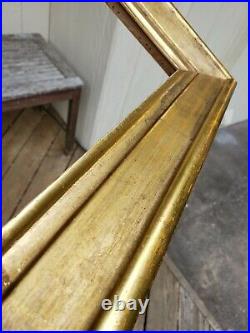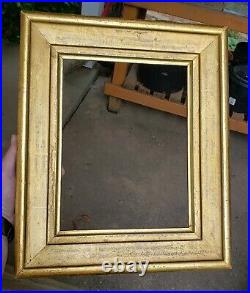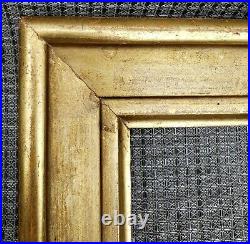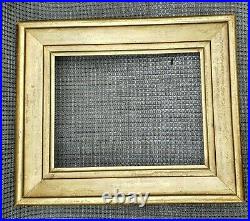
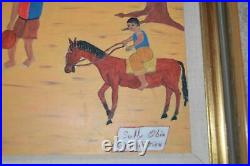



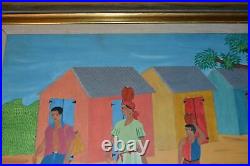

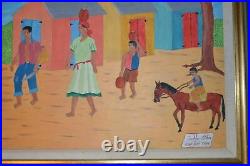

THE TOP OF THE FRAME HAS BEEN TAPED AND STAPLED. OBTAINED DIRECTLY FROM THE ARTIST. Haiti, 1947; active Port-au-Prince, 1970. MONOGRAPHS AND SOLO EXHIBITIONS. GENERAL BOOKS AND GROUP EXHIBITIONS. BLONCOURT, GERALD and MARIE-JOSE NADAL-GARDERE. La Peinture Haitienne / Haitian Arts. Paris: Editions Nathan, 1986. Over 100 color plates, photos of artists, chronols. On individual artists, general chronology, index of artists which seems to end with W in all copies we have seen. Many dozens of artists are listed only by name in the index with no further information and no illustration. By Gesner Armand; texts by Bloncourt, Dewitt Peters; chronols. By Pierre Monosiet and Marie-Jose Nadal. In French and English. Important inclusion of the broader group of Haitian artists, including many hitherto little-noted women painters and modernists, also some sculptors in spite of the book’s title. Includes: Gesner Abelard, Willy Abelard, Jocelyn Agenor, Leon Agnant, Gerald Alexis, Gabriel Alix, Ralph Allen, Jean-Claude Almonor, Occide Almonor, Volvick Almonor, Fritzner Alphonse, Michel-Ange Altidor, Hector Ambroise, Jackson Ambroise, Xavier Amiama, Montas Antoine, Gesner Armand, Gesner Armand, Georges Auguste, Wilfrid (Frido) Austin, Forest Avril, Castera Bazile, Mario Benjamin, Rigaud Bénoit, Wilson Bigaud, Roland Blain, Fabolon Blaise, Serge Moléon Blaise, Saint-Louis Blaise, Sisson Blanchard, Smith Blanchard, Gerald Bloncourt, Noemie Clainville Bloncourt, Ludovic Booz, Maurice Borno, Jean-Baptiste Bottex, Seymour Etienne Bottex, Henry Robert Brésil, Murat Brierre (sculptor), Bourmond Byron, Robert St. Brice, Jean-Claude Castera, Marie-Hélène Cauvin, Dieudonné Cédor, Ralph Chapoteau, Etienne Chavannes, Jacques-Richard Chéry, Préfète Duffaut, Raphael Denis, Villard Dennis, Rose-Marie Desruisseaux, André Dimanche (sculptor), Roland Dorcély, Guy A. Dorcin, Nicholas Dreux, Abner Dubic, Henri Dubreuil, Gervais Emmanuel Ducasse, Alfred Dujour, Joubert Duperrier, Odilon Duperrier, Edouard Duval-Carrié, Jacques Enguerrand-Gourgue, Franck Etienne, Levoy Exil, Celestin Faustin, Lafortune Felix, Gerard Fombrun, Jacques Gabriel, Serge Gay, Max Gerbier, Jacques Geslin, Alexandre Gregoire, Elsie Haas, Georges Hector, Calixte Henry, Edith Hollant, Hector Hyppolite, Saincilus Ismael, Harry Jacques (aka Arijac), Eugene Jean, Francoise Jean, Nehemy Jean, Jean-Baptiste Jean, Carlo Jean Jacques, Eric Jean-Louis, Henri Jean-Louis, Guy Joachim, Antonio Joseph, Casimir Joseph, Fritz-Edouard Joseph, Jasmin Joseph, Nacius Joseph, Pierre Joseph, Reyald Joseph, Wifredo Lam, Gisou Lamothe, Georges Laratte, Franklyn Latortue, Philton Latortue, Lyonel Laurenceau, Peterson Laurent, Luckner Lazard, Hervé Lebreton, Jean-Claude Legagneur, Adam Leontus, Georges Liautaud (sculptor), Jacques Liautaud, Janvier Louisjuste, Joseph Louisjuste, Seresier Louisjuste, Franck Louissaint, Ernst Louizor, Andrée Malebranche, Elzire Malebranche, Descollines Manes, Albert Mangones, Monique Mangones, Michele Manuel, Emmanuel Merisier, Ronald Mevs, Madsen Mompremier, Pierre Monosiet, Amerigo Montagutelli, Sully Moreau, Abner Mortimer, Abraham Mucius, Cesar Muller, Frantz Multidor, Gilda Thebaud Nassief, Andrée Georges Naude, André Navel, Paul Nemours, Vincent Nemours, Jacqueline Nesti, André Normil, Hervé Normil, Nooz, Charles Obas, Antoine Obin, Claude Obin, Donald Obin, Harrison Obin, Henri-Claude Obin, Jean-Marie Obin, Michaelle Obin, Michel Obin, Othon Obin, Philomé Obin, Seneque Obin, Sully Obin, Télémaque Obin, Gerard Olivier, Raymond Olivier, Daniel Orelus, Frantz Oriol, Felipe Orlando, Rémy Paillant (as Paillan), Pierre Pailliere, Roland Palanquet, Francis Paraison, Robal Paris, Rev. Jean Parisot, André J. Pascal, Damien Paul, Gerard Paul, Manno Paul, Jean-Baptiste Pericles, Frida Perou, Clara Petit, Yves Phanor, Prosper Phildor, Robert Philippe-Auguste, Salnave Philippe-Auguste, Marilene Phipps, Viviane Phipps, André Pierre, Antoine Pierre, Fernand Pierre, Frederic Pierre, René Pierre, Sonny Pierre, Vierge Pierre, Willy Pierre, Wilner Pierre, Evans Pierre-Augustin, Pierre Pierre-Canel, Emmanuel Pierre-Charles, Immacula Pierre-Louis, Prospere Pierre-Louis, Raymond Pierre-Louis, Wesner Pierre-Louis, Louis Vergniaud Pierre-Noel, Emmanuel Pierrette, Max Pinchinat, Enock Placide, Dieudonné Pluviose, Ronel Pointdujour, Serge Pointdujour, Fontenel Pointjour, Louverture Poisson, Jerome Polycarpe, Lamy Pomayrac, Fidelio Ponce, René Portocarrero, Lucie Poux, F. Pressoir, Edouard Preston, Frantz Prézumé, Guerdy Préval, Michel Préval, Emmanuel Prévil, Micheline Prézeau, Lucien Price, Yvon Princivil, Jonas Prophil, Cameau Rameau, Marcel Raveau, Dorleans Raymond, Geo Remponeau, Guy Reserve, Revinchal, Albert Rigaud, Jean-Claude Rigaud, Louis Rigaud, Franck Robuste, Jean-Claude Robuste, Camy Rocher, Ignacio Rocit, Gerald Rocourt, Fritz Rock, Samuel Roker, Louis Rosemond, Dieudonné Rouanez, Henry Rouanez, David Rouzier, Alix Roy, Marie-Florence Roy-Mason, Georges Saieh, Camille Saint-Aude, Robert St. Croix, Lionel St-Eloi, Jean St. Rome, Emmanuel St. Vil, Salem, Emilio Sanchez, Pétion Savain, Micius Stéphane, Hervé Télémaque, Carol Theard, Jean-Pierre Theard, Buffon Thermidor, Camille Torchon, Saint-Pierre Toussaint, Luce Turnier, Jacques Valbrun, Favrange Valcin, Gerard Valcin, Pierre-Joseph Valcin, Maurice Vital, Louis Vassor, Denis Vergin, Hernod Versaint, Raoul Viard, Philippe Vieux, Patrick Vilaire, Alexis Vincent, Joseph Vincent, Rene Vincent, Diecilius Vital, Maurice Vital, Pauleus Vital, Jean-Dominique Volcy, Bernard Wah, Edgard Wah, Edouard Wah, Ghislaine Wah, Jean-Marcel Wah, Marcel K. Wah, Patrick Gerald Wah. Hilda Williams, Edner Wilner, Jean Wilner, Robert (Bob) Wilson. 4to 12.1 x 9.3 in. , brown cloth, pictorial d. Haitian Painting: Art and Kitsch. Chicago: Adams Press, 1986. Text plus list of 2000 Haitian painters. Selective crosslistings to approx. 200 of the many listed artists. Ulm: International Primary Art, n. 38 b&w, 83 excellent quality color plates, including covers, biogs. Of 49 artists with some b&w photos, exhibs. A few short essays, followed by a dictionary-like presentation of the artists, arranged in alphabetical order. Includes: Gabriel Alix, Volvick Almonor, Montas Antoine, Castera Bazile, Rigaud Bénoit, Wilson Bigaud, André Blaise, Sisson Blanchard, Edgar Brierre, A. Calixtes, Jacques-Richard Chery, Guy Desir, Wilmino Domond, Gervais Emmanuel Ducasse, Préfète Duffaut, Roland Etienne, Célestin Faustin, Felix LaFortune, Max Gerbier, Jacques Enguerrand Gourgue, Hector Hyppolite, Edner Jean, Eugene Jean, Paul Jean, Jean Jean-Baptiste, Guy F. Joachim, Serge Jolimeau, Jasmin Joseph, Jean-Baptiste Jean, Wesner LaForest, Casimir Laurant, Joseph Jean-Laurent, Adam Leontus, G. Leriche, Georges, Liautaud, Antoine Obin, Philomé Obin, Seneque Obin, Sully Obin, Télémaque Obin, Ernest Paul, Eric Phanord, Philippe Auguste Salnave, André Pierre, Dieudonné Pluviose, Ernst Prophète, Robert St. Brice, Micius Stéphane, Gerard Valcin, Pierre-Joseph Valcin, Jean Wilner. Published in association with the exhibition at the Kunsthalle, Berlin, June 24-August 12, 1980. 8vo, pictorial papered boards. Sully Obin was the eldest son of Sènêque Obin and a nephew of the great Philomé Obin who founded the School of Cap-Haitian. Sully is a distinguished painter from the Cap-Haitian school, the chief interest in his works is historical. He was born in Cap- Haitien, Haiti in 1916 and may have passed away in 2012. Haitian art is a complex tradition, reflecting African roots with strong Indigenous, American and European aesthetic and religious influences. It is an important representation of Haitian culture and history. Many artists cluster in “schools” of painting, such as the Cap-Haïtien school, which features depictions of daily life in the city, the Jacmel School, which reflects the steep mountains and bays of that coastal town, or the Saint-Soleil School, which is characterized by abstracted human forms and is heavily influenced by “Vaudou” symbolism. Diaspora outside of Haiti. The Centre d’Art is an art center, school and gallery located in Port-au-Prince, Haiti. It was founded in 1944 by American watercolorist DeWitt Peters and several prominent Haitians from the intellectual and cultural circles including: Maurice Borno, Andrée Malebranche, Albert Mangonès, Lucien Price, and Georges Remponeau. [1] Popular artists of this movement often were influenced by vaudou and include: André Pierre, Hector Hippolyte, Castera Bazile, Wilson Bigaud and Rigaud Benoit. [2] Haitian art is a type of artwork is often characterized by vivid colors, spatial composition and spontaneity of painting. Saint Soleil School, also known as “Movement Saint-Soleil” was founded in 1973 as a rural arts community called Soisson-la-Montagne, in Pétion-Ville, Haiti. [3] This community was started by Jean-Claude Garoute and Maud Robart and they encouraged the academic study of painting, as well as maintaining influence by vaudou. [3] Saint Soleil art is characterized by abstract human forms and the heavy influence of vaudou symbolism. After Saint Soleil School disbanded, five remaining members of the school were renamed “Cinq Soleil” and include: Levoy Exil, Prosper Pierre Louis, Louisiane Saint Fleurant, Dieuseul Paul, Denis Smith. A second generation member is Magda Magloire, the daughter of Louisiane Saint Fleurant. The painters of the Artibonite department in north-western Haiti, where Hôpital Albert Schweitzer is located, have developed their own style, which is quite recognizable. Ismaël began to paint in 1956 after visiting the Centre d’Art in Port-au-Prince. His paintings are marked by exquisite detail. Every article of clothing, house, or tree is painted with a different intricate geometric pattern. Délouis Jean-Louis grew up in Petite Rivière under the influence of Ismaël. Although he worked under Ismaël for 15 years, he never had formal painting lessons. Alix Dorléus also learned to paint with Ismaël and Mrs. He paints all day long and will paint anywhere he feels the spirit to motivate him. His best paintings are detailed depictions, like activity maps, of daily life in the Artibonite Valley. Ernst Louizor is considered one of the best impressionist painters of Haiti. [citation needed] Louzor was born in Port-au-Prince on 16 October 1938. Louizor’s painting career began in 1951, when at the age of 13 he joined the Centre d’Art and studied under Wilmino Domond. He later entered the Académie des Beaux-Arts shortly after its founding in 1959 and furthered his studies with Georges Remponeau. Louzor has many disciples including his wife Gerda Louizor. He has exhibited in Europe and the United States. Notable artists of Haitian descent and members of the diaspora include Jean-Michel Basquiat, Hersza Barjon and Ernst Registre. Market painting is a Haitian archetype, originating with Laurent Casimir. The motive is often dense with people. These paintings were mass-produced by Laurent Casimir and his apprentices in the mid-1970s, all signed by Casimir. [4][non-primary source needed] This archetype is later taken up by contemporary Haitian artist like Jean-Louis, many of which studied under Laurent Casimir. There is evidence that sculpture from the Tainos in Haiti existed in the Pre-Columbian era and they would create dolls, drawings, signs. [2] It is speculated by researchers that these sculptures may have been representing their deities (maybe the ancestors of the vèvè in vaudou). Contemporary Haitian sculpture is made of natural materials, traditional art mediums, and recycled materials. “Haitian Steel Drum Sculpture” – The village of Noailles in Croix-des-Bouquets is home to more than a dozen artisan workshops producing countless pieces for over two decades. The work is created out of recycled oil drums. In August 2011, the Clinton Global Initiative along with Greif Inc. Donated 40 tons of scrap metal to the artists in Croix-des-Bouquets. After the earthquake in 2010, artists had a difficult time finding material to work from. According to Deputy Jean Tholbert Alexis, 8,000 people in the area are directly or indirectly benefit from the villages’ artisans. The tradition of making flags (drapo servis) to decorate Vodou places of worship is a distinctive form of Haitian Vodou art. Flags most often commemorate specific spirits or saints, but the 2010 earthquake has become a common subject of art flags. The use of sequins in these flags became prevalent in the 1940s, and many of today’s flags cover the entire flag in colored sequins and beads. These flags are traded as art by dealers around the world. On 12 January 2010 a devastating earthquake struck Port-au-Prince and its surrounding area and resulted in mass devastation. [6] The Haitian art world suffered great losses in the earthquake. Museums and art galleries were extensively damaged, among them Port-au-Prince’s main art museum, Centre d’Art, where many art works were destroyed. The collection at Collège Saint Pierre also was devastated, as was the collection of priceless murals in the Holy Trinity Cathedral. [7] Some private art galleries were also severely damaged, including the Monnin Gallery in Pétion-Ville, [7] and the Nader Art Gallery and Musée Nader in Port-au-Prince. Shortly after the earthquake struck, UNESCO assigned special envoy Bernard Hadjadj to evaluate damage to artwork. [8] The Smithsonian Institution, led by Under Secretary Richard Kurin, and with the assistance of the U. Embassy in Port-au-Prince and the Government of Haiti among others, embarked on a multiyear project and survey to help restore key Haitian cultural treasures and train local Haitians on art preservation and recovery techniques. Cap-Haïtien French: kap a. I. Sj? ~; Haitian Creole: Kap Ayisyen; English: Haitian Cape and typically spelled Cape Haitien in English often referred to as Le Cap or Au Cap, is a commune of about 190,000 people on the north coast of Haiti and capital of the department of Nord. Previously named Cap-Français (Haitian Creole: Kap-Fransè; initially Cap-François[4] Haitian Creole: Kap-Franswa) and Cap-Henri (Haitian Creole: Kap-Enri) during the rule of Henri I, it was historically nicknamed the Paris of the Antilles, because of its wealth and sophistication, expressed through its architecture and artistic life. [5][6][7][8] It was an important city during the colonial period, serving as the capital of the French Colony of Saint-Domingue from the city’s formal foundation in 1711 until 1770 when the capital was moved to Port-au-Prince. After the Haitian Revolution, it became the capital of the Kingdom of Haiti under King Henri I until 1820. Cap-Haïtien’s long history of independent thought was formed in part by its relative distance from Port-au-Prince, the barrier of mountains between it and the southern part of the country, and a history of large African populations. These contributed to making it a legendary incubator of independent movements since slavery times. For instance, from February 5-29, 2004, the city was taken over by militants who opposed the rule of the Haïtian president Jean-Bertrand Aristide. They eventually created enough political pressure to force him out of office and the country. Cap-Haïtien is near the historic Haitian town of Milot, which lies 19 kilometres (12 mi) to the southwest along a gravel road. Milot was Haiti’s first capital under the self-proclaimed King Henry Christophe, who ascended to power in 1807, three years after Haiti had gained independence from France. He renamed Cap-Français as Cap-Henri. Milot is the site of his Sans-Souci Palace, wrecked by the 1842 earthquake. The Citadelle Laferrière, a massive stone fortress bristling with cannons, atop a nearby mountain is eight kilometres (5 mi) away. On clear days, its silhouette is visible from Cap-Haïtien. The small Cap-Haïtien International Airport, located on the southeast edge of the city, is served by several small domestic airlines. It has been patrolled by Chilean UN troops from the “O’Higgins Base” since the 2010 earthquake. The airport is currently being expanded. Several hundred UN personnel, including nearby units from Nepal and Uruguay, are assigned to the city as part of the ongoing United Nations Stabilization Mission in Haiti (MINUSTAH). Labadie and other beaches. Citadelle Henry and Sans-Souci Palace. Cap-Haïtien fuel tanker explosion. The well-preserved Cathedral Notre-Dame of Cap-Haïtien. The island was occupied for thousands of years by cultures of indigenous peoples, who had migrated from present-day Central and South America. In the 16th century, Spanish explorers in the Caribbean began to colonize the island. They adopted the native name, Guárico for this area that is today known as “Cap-Haïtien”. [9] Due to the introduction of new infectious diseases, as well as poor treatment, the indigenous peoples population rapidly declined. On the nearby coast Columbus founded his first community in the New World, the short-lived La Navidad. In 1975, researchers found near Cap-Haïtien another of the first Spanish towns of Hispaniola: Puerto Real was founded in 1503. It was abandoned in 1578, and its ruins were not discovered until late in the twentieth century. A street scene in Cap-Haïtien. The French occupied roughly a third of the island of Hispaniola from the Spanish in the early eighteenth century. They established large sugar cane plantations on the northern plains and imported tens of thousands of African slaves to work them. Cap-Français became an important port city of the French colonial period and the colony’s main commercial centre. [5] It served as the capital of the French colony of Saint-Domingue from the city’s formal founding in 1711 until 1770, when the capital was moved to Port-au-Prince on the west coast of the island. After the slave revolution, this was the first capital of the Kingdom of Haiti under King Henri I, when the nation was split apart. The central area of the city is between the Bay of Cap-Haïtien to the east and nearby mountainsides to the west; these are increasingly dominated by flimsy urban slums. The streets are generally narrow and arranged in grids. As a legacy of the United States’ occupation of Haiti from 1915 to 1934, Cap-Haïtien’s north-south streets were renamed as single letters (beginning with Rue A, a major avenue) and going to “Q”, and its east-west streets with numbers from 1 to 26; the system is not followed outside the central city, where French names predominate. The historic city has numerous markets, churches, and low-rise apartment buildings (of three-four storeys), constructed primarily before and during the U. Much of the infrastructure in need of repair. Many such buildings have balconies on the upper floors, which overlook the narrow streets below. With people eating outside on the balconies, there is an intimate communal atmosphere during dinner hours. Engraving of Cap-Français in 1728. Fire of Cap Français, 21 June 1793. The French army led by Le Clerc lands in Cap Français (1802). American Marines in 1915 defending the entrance gate in Cap-Haïten. Marine’s base at Cap-Haïtien. French colonial architecture in Cap. Cap-Haïtien is known as the nation’s largest center of historic monuments and as such, it is a tourist destination. The bay, beaches and monuments have made it a resort and vacation destination for Haiti’s upper classes, comparable to Pétion-Ville. Cap-Haïtien has also attracted more international tourists at times, as it has been isolated from the political instability in the south of the island. It has a wealth of French colonial architecture, which has been well preserved. During and after the Haitian Revolution, many craftsmen from Cap-Haïtien, who were free people of color, fled to French-controlled New Orleans as they were under attack by the mostly African slaves. As a result, the two cities share many similarities in styles of architecture. Especially notable are the gingerbread houses lining the city’s older streets. Labadie beach and village. The walled Labadie (or Labadee) beach resort compound is located ten kilometres (6 mi) to the city’s northwest. It is a private resort leased by RCI, which has generated the largest proportion of tourist revenue to Haiti since 1986. The resort is connected to Cap-Haïtien by a mountainous, recently paved road. [11] Attractions include a Haitian market, numerous beaches, watersports, a water-oriented playground, and a zip-line. [12] People not on cruises can visit the beach, too. Water taxis parked at Labadie beach. A view of the beach at Paradis. Cormier Plage is another beach on the way to Labadie, and there are also water taxis from Labadie to other beaches, like Paradis beach. In addition, Belli Beach is a small sandy cove with boats and hotels. Labadie village could be visited from here. Vertières is the site of the Battle of Vertières, the last and defining battle of the Haitian Revolution. On November 18, 1803, the Haitian army led by Jean-Jacques Dessalines defeated a French colonial army led by the Comte de Rochambeau. The French withdrew their remaining 7,000 troops (many had died from yellow fever and other diseases), and in 1804, Dessalines’ revolutionary government declared the independence of Haiti. The revolution had been underway, with some pauses, since the 1790s. In this last battle for independence, rebel leader Capois La Mort survived all the French bullets that nearly killed him. His horse was killed under him, and his hat fell off, but he kept advancing on the French, yelling, En avant! He has become renowned as a hero of the revolution. The 18 of November has been widely celebrated since then as a Day of Army and Victory in Haiti. View of the Citadelle Laferrière, in northern Haiti. Inside the ruins of Sans Souci Palace. The Citadelle Laferrière, also known as Citadelle Henry, or the Citadelle, is a large mountaintop fortress located approximately 27 kilometres (17 mi) south of the city of Cap-Haïtien and eight kilometres (5 mi) beyond the town of Milot. It is the largest fortress in the Americas, and was listed by UNESCO as a World Heritage Site in 1982 along with the nearby Sans-Souci Palace. The Citadel was built by Henry Christophe, a leader during the Haitian slave rebellion and self-declared King of Northern Haiti, after the country gained its independence from France in 1804. Together with the remains of his Sans-Souci Palace, damaged in the 1842 earthquake, Citadelle Henry has been designated as a UNESCO World Heritage Site. Further information: Bois Caïman. Bois Caïman (Haitian Creole: Bwa Kayiman), three kilometres (2 mi) south of road RN 1, is the place where Vodou rites were performed under a tree at the beginning of the slave revolution. For decades, maroons had been terrorizing slaveholders on the northern plains by poisoning their food and water. Makandal is the legendary (and perhaps historical) figure associated with the growing resistance movement. By the 1750s, he had organized the maroons, as well as many people enslaved on plantations, into a secret army. Makandal was murdered (or disappeared) in 1758, but the resistance movement grew. At Bois Caïman, a maroon leader named Dutty Boukman held the first mass antislavery meeting secretly on August 14, 1791. At this meeting, a Vodou ceremony was performed, and all those present swore to die rather than to endure the continuation of slavery on the island. Following the ritual led by Boukman and a mambo named Cécile Fatiman, the insurrection started on the night of August 22-23, 1791. Boukman was killed in an ambush soon after the revolution began. Jean-François was the next leader to follow Dutty Boukman in the uprising of the slaves, the Haitian equivalent of the storming of the Bastille in the French Revolution. Slaves burned the plantations and cane fields, and massacred French colonists across the northern plains. They also attacked Cap-Français and some of the free people of color. Eventually the revolution gained the independence of Haiti from France and freedom for the slaves. The site of Dutty Boukman’s ceremony is marked by a ficus tree. Adjoining it is a colonial well, which is credited with mystic powers. Morne Rouge is eight kilometres (5 mi) to the south of Cap. It is the site of the sugar plantation known as “Habitation Le Normand de Mezy”, known for several slaves who led the rebellion against the French. Main article: 1842 Cap-Haïtien earthquake. On 7 May 1842, an earthquake destroyed most of the city and other towns in the north of Haiti and the neighboring Dominican Republic. Among the buildings destroyed or significantly damaged was the Sans-Souci Palace. Ten thousand people were killed in the earthquake. [16] Its magnitude is estimated as 8.1 on the Richter scale. Main article: 2010 Haiti earthquake. As the city’s infrastructure suffered little damage, numerous businessmen and many residents have moved here from Port-au-Prince. The airport is patrolled by Chilean UN troops since the 2010 earthquake, and several hundred UN personnel have been assigned to the city as part of the ongoing United Nations Stabilization Mission in Haiti (MINUSTAH). They are working on recovery throughout the island. Main article: Cap-Haïtien fuel tanker explosion. On 14 December 2021, over 75 people were killed when a fuel tank truck overturned and later exploded in the Samari neighborhood of Cap-Haïtien. Cap-Haïtien is served by the Cap-Haïtien International Airport (CAP), Haiti’s second busiest airport. [18] It was a hub for Salsa d’Haiti prior to its cessation in 2013. American Airlines operated international flights to CAP for a number of years, but canceled their last connection in July, 2020, after the -19 pandemic significantly reduced passenger demand. American Airlines was the last major US flight operator to provide service to CAP and thereby Northern Haiti-in July, 2020, Cap-Haïtien became only accessible by air travel through limited flights into Port-au-Prince’s Toussaint Louverture International Airport. [19] Spirit Airlines, which had previously canceled their service due to political unrest and low demand in 2019, announced in October, 2020 that they would resume limited service to CAP in December of the same year. The Port international du Cap-Haïtien is Cap-Haïtien’s main seaport. The Route Nationale#1 connects Cap-Haïtien with the Haitian capital city Port-au-Prince via the cities of Saint-Marc and Gonaïves. The Route Nationale#3 also connects Cap-Haïtien with Port-au-Prince via the Central Plateau and the cities of Mirebalais and Hinche. Cap-Haïtien has one of the best grid systems in Haiti with its north-south streets were renamed as single letters (beginning with Rue A, a major avenue), and its east-west streets with numbers. The Boulevard du Cap-Haitian (also called the Boulevard Carenage) is Cap-Haïtien’s main boulevard that runs along the Atlantic Ocean in the northern part of the city. Cap-Haïtien is served by tap tap and local taxis or motorcycles. Cap Haitien is served by the teaching hospital: Hôpital Universitaire Justinien. A union of four Catholic Church private schools have been present for two decades in Cap-Haïtien. They have higher-level grades, equivalent to the lycées that feed the Écoles Normale Supérieure in France. They have high standards of academic excellence, selectivity in admissions, and generally their students come from the social and economic elite. Also, the lyceé Philippe Guerrier that was built in 1844 by the Haitian President, Philippe Guerrier, has been a fountain of knowledge for more than a century. Collège Notre-Dame du Perpetuel Secours des Pères de Sainte-Croix. Collège Regina Assumpta des Sours de Sainte-Croix. École des Frères de l’instruction Chrétienne. École Saint Joseph de Cluny des Sours Anne-Marie Javoue. Lyceé Philippe Guerrier built by the Haitian President, Philippe Guerrier in 1844. Cap Haitien is home to the Cap-Haitien Faculty of Law, Economics and, Management; the Public University of the North in Cap Haitien (UPNCH). The new Université Roi Henry Christophe is nearby in Limonade. Cap Haitien has the Parc Saint-Victor home of three major league teams: Football Inter Club Association, AS Capoise, and Real du Cap. The commune consists of three communal sections, namely. Bande du Nord, urban (part of the commune of Cap-Haïtien) and rural. Haut du Cap, urban (part of the commune of Cap-Haïtien) and rural. Petit Anse, urban (commune of Petit Anse) and rural. Tyrone Edmond, Haitian-born model. Fred Joseph Jr, Haitian-born philanthropist. Founder and president of Help Us Save Us Non-Profit Organization. Louis Mercier, Haitian educator (born May 5, 1893 in Cap-Haïtien). Alfred Auguste Nemours, military historian and diplomat. Ulrick Pierre-Louis, founder of orchestre Septentrional. Front view of Sans-Souci Palace. Hotel de Ville (City Hall), site of the City Council, Cap-Haïtien. Télé Vénus Ch 5. Télé Paradis Ch 16[22]. Télé Capoise Ch 8. Télé Africa Ch 12[23]. Télé Union Ch 22. Télé Apocalypse Ch 24. Télévision Nationale d’Haiti Ch 4[24]. This item is in the category “Art\Paintings”. The seller is “memorabilia111″ and is located in this country: US. This item can be shipped to United States, Canada.
- Production Technique: Oil Painting
- Style: Outsider Art
- Type: Painting





